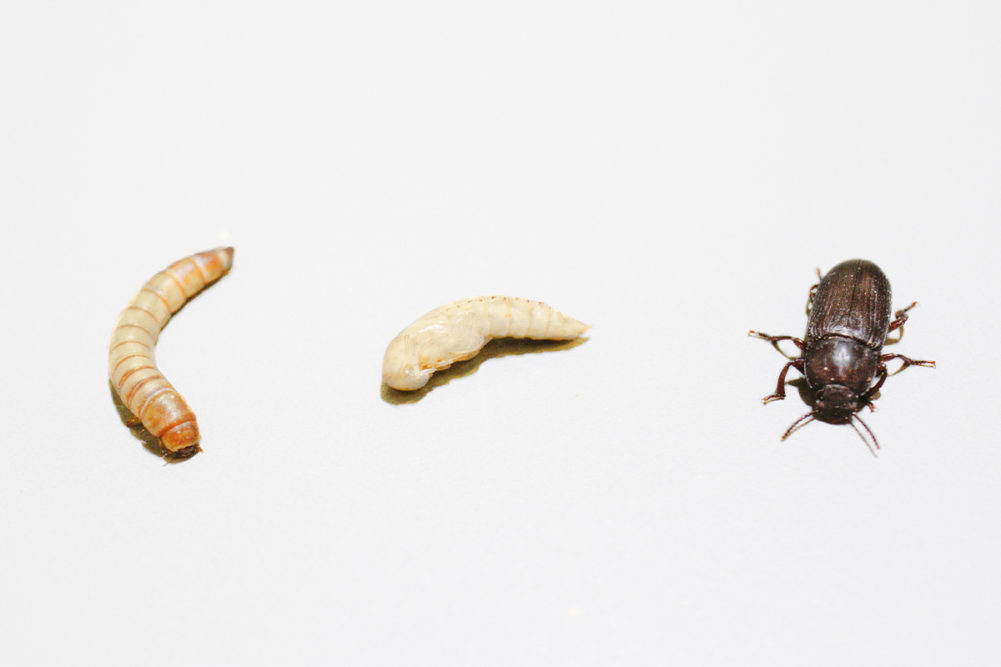This article was published in the May 2023 issue of Pet Food Processing. Read it and other articles from this issue in our May digital edition.
It’s been 25 years since Julieta Ramos-Elorduy, a professor with the Institute of Biology at the National University of Mexico in Mexico City, published “Creepy Crawly Cuisine: The Gourmet Guide to Edible Insects.” With recipes such as batter-fried dragonflies, stink bug pate and wasp salad, she had hoped to turn US consumers on to eating insects, a sustainable source of protein common to cultures in most other parts of the world. Unfortunately, the practice of humans eating insects — anthropo-entomophagy — in America has not taken off, mostly due to the “ick” factor. For pets, however, there is appeal.
“Pets eat insects when they are in the backyard,” said Cynthia Dunston Quirk, founder, Scout & Zoe’s, Anderson, Ind. “Pet owners may be grossed out by that, but that’s how I had the idea to begin researching insects for treat ingredients.”
Scout & Zoe’s created jerky for canines using black soldier fly larvae (BSFL) in 2019. That’s when the Association of American Feed Control Officials (AAFCO) was first introduced to BSFL as a potential dog food ingredient. In August 2021, AAFCO voted to approve its use in adult dog food, joining approved use in salmonid, poultry and swine feed. Currently, BSFL is the only insect product that has successfully gone through the AAFCO ingredient definition process. Usage for felines is under review.
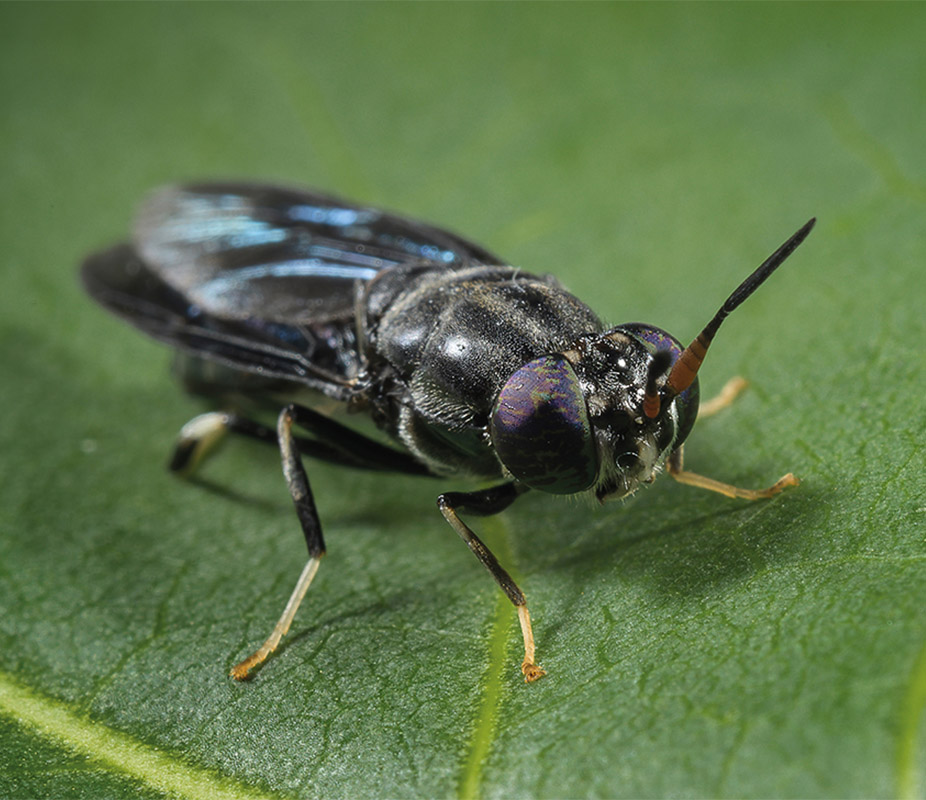
Black soldier fly larvae is currently the most common insect protein used in pet food. Its brief life cycle allows for large-scale and long-term production of the insect.
|“A lot of research was invested in determining the best insect for the job,” said Suzanne van den Eshof, director of marketing and business development, Protix, Dongen, the Netherlands. “The black soldier fly proves superior to other insects in many ways. Its larvae contain more nutrients than the larvae of other insects because the mature insect does not eat, and has to live off these accumulated reserves. The black soldier fly also has a voracious appetite and is able to convert feedstuff effectively. This supports a circular food chain that exploits organic waste streams that would otherwise be unused. Moreover, its brief life cycle allows large-scale and long-term production.”
While BSFL may be the most commonly used insect in pet food, other insects are being used in the United States and abroad. Jiminy’s, Berkeley, Calif., for example, works with crickets and grubs.
Sustainable messaging
When sourcing protein from smaller animals, less land and water is used, explained Anne Carlson, founder and chief executive officer of Jiminy’s. This makes insects very sustainable sources of protein.
“Grubs and crickets are an amazingly efficient food source, as they take up a fraction of the acres required by a cattle feedlot,” Carlson said. “Water usage is similar. Insects require a fraction of the amount needed by cattle or chickens. The delivery system itself prevents waste too, so we’re getting mileage out of every drop of water.”
One 5-oz. bag of Jiminy’s treats saves 200 gallons of water, according to Carlson.
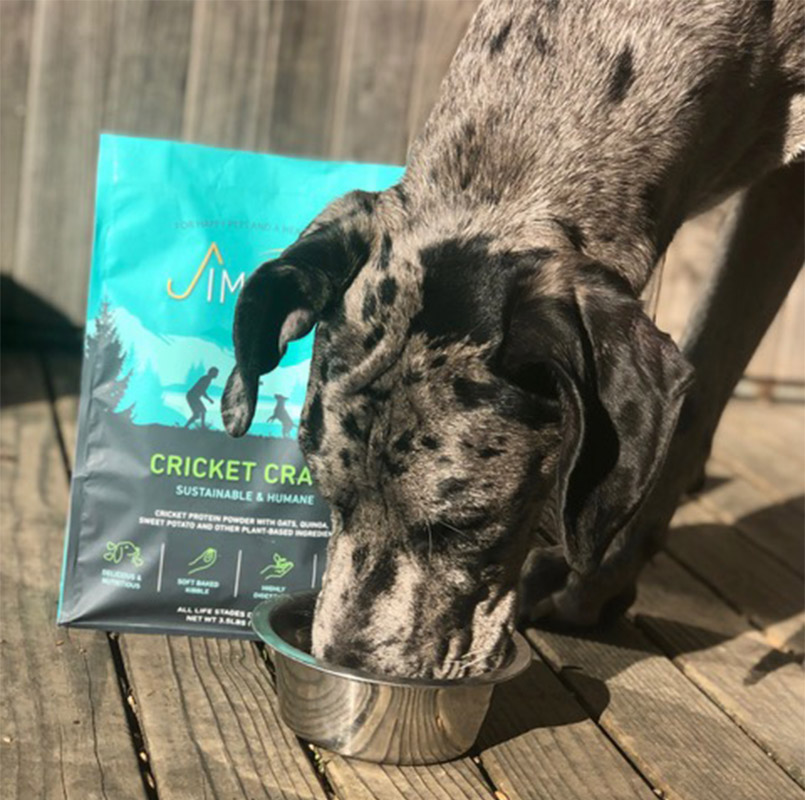
Jiminy’s sources sustainable cricket protein for its dog food products.
|“Insect ingredients simply make a more sustainable pet food product, and sustainability is becoming increasingly important to a growing number of pet parents,” said Bjarne Gravesen Jensen, co-founder and chief executive officer, Globe Buddy, Tjele, Denmark. “But it’s vital that pet food brands are honest and transparent, for example, by having a verified product carbon footprint. If not, then green claims with insects tend to be bad buzzword marketing and a pretentious attempt to impress.”
Dunston Quirk added, “Just the fact that the larvae can grow and be harvested in about seven days is amazing. When raising larvae is compared to raising beef, it takes approximately 18 months to raise and harvest cattle. And the land required to raise cattle is staggering verses the small footprint of the humble BSFL.
“It dines and grows on fruit and veggie waste using no additional water,” Dunston Quirk said. “It releases zero methane gas into the environment. Billions of larvae grow in a very compact space. Such an amazing little critter. Delicious, too.”
Sustainability is just one of the attractions to using insect ingredients in pet foods and treats. Another is the fact that when insect protein is used instead of whole muscle beef, chicken, pork, etc., those other meats become available for human consumption, which will help in the future to feed the growing population.
And the best part — insect ingredients are nutrient dense. They are loaded with all the good things pets need in their diets.
“Insects are really worthy of superfood status,” Gravesen Jensen said. “They are rich in the same essential amino acids that the pet would get from traditional meat. Insect protein has high digestibility, and on top of that, insects also provide essential fatty acids and minerals.”
Globe Buddy works with BSFL and mealworms. When these alternative proteins are used in a recipe, they are labeled as such on packages and contribute to a desirable nutritional profile.
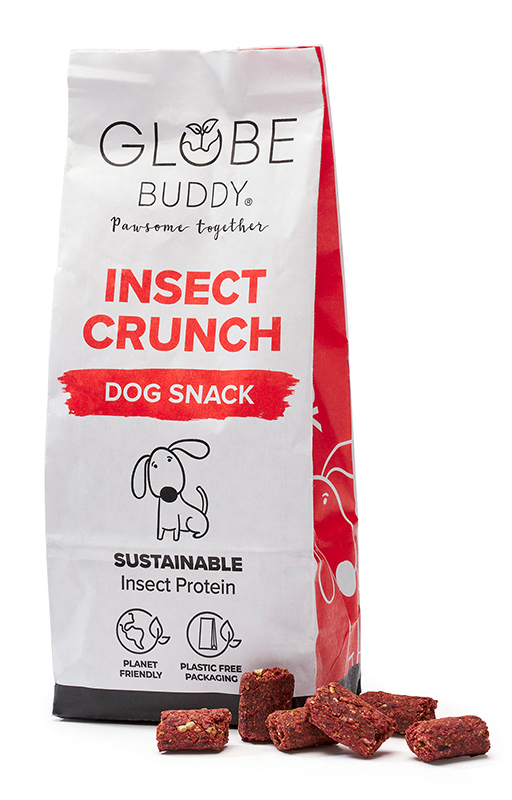
Globe Buddy’s Insect Crunch dog snack is made from 25% mealworms and 5% black soldier fly larvae, as well as other vegetable ingredients.
|Dunston Quirk believes that transparency and education are critical to pet parent acceptability of insect ingredients. The Scout & Zoe’s products that contain BSFL are marketed as such on front panels. This is a useful callout to pet parents that may be looking for alternative protein sources due to their pet’s sensitivities or allergies to traditional proteins. It also helps in raising awareness.
“We utilize BSFL — whole larvae, powdered larvae and oil — in our treats,” Dunston Quirk said. “In our ingredient panel, we list it as ‘black soldier fly larvae.’”
Inclusion of these forms in different types of treats varies with the type of treat being made. Scout & Zoe’s packages powdered dried larvae as a food topper. The oil is packaged as a food topper as well. The powder also goes into the jerky for canines.
Compared to the current market price for chicken, turkey and beef, BSFL are an economically priced protein, Dunston Quirk said. The larvae can be blended with other proteins to alter the palatability of a product or change the consistency.
“We have not seen any significant difference in the shelf life of products using the larvae versus any other protein if the water activity is at appropriate levels,” she added. “With any treat, when water activity exceeds normal ranges, that treat may become compromised.”
Innovations overseas
In addition to BSFL, other insect ingredients are authorized for use in both cat and dog food across Asia, Canada and Europe. The global insect industry is collaborating through the proper regulatory channels in the United States to open up the market. Right now, suppliers are investing to make insect ingredients even more attractive.
“As pet owners want to take better care of their animals — especially as they increasingly see their pets as family members — pet food and treat manufacturers are looking for new high-quality ingredients to meet the demand for healthy and nutritious feeds,” said Sean Madison, director of North American business development, Innovafeed, Paris. “Furthermore, with the United Nations Food and Agriculture Organization predicting a protein deficit of 30 to 40 million tonnes by 2030, securing sustainable sources of protein will be critical in the future for pet food manufacturers.”
“Grubs and crickets are an amazingly efficient food source, as they take up a fraction of the acres required by a cattle feedlot,” said Anne Carlson, founder and chief executive officer of Jiminy’s.
Innovafeed breeds BSFL in large-scale plants based on vertical, zero waste and circular model farms. The company uses all parts of the insect. This includes the production of two types of BSFL ingredients for pet food.
Defatted dried BSFL meal is a highly concentrated source of premium protein with a balanced amino acid profile, according to Madison. The BSFL oil is a source of healthy fatty acids, in particular, the medium-chain triglyceride lauric acid, which has antimicrobial and antioxidant properties and can improve digestion.
“Insect ingredients can be used like any other traditional protein and oil sources into pet feed and treats and there are many references in the literature describing their safety and efficacy,” Madison said.
Innovafeed signed a partnership agreement with Archer Daniels Midland (ADM), Chicago, in 2020 to build the largest insect protein plant in the world by 2025 in Decatur, Ill., with a capacity of 60,000 tons of insect protein per year. ADM corn co-products will be recycled locally to feed the insects through infrastructures connected to the site. This production model will allow Innovafeed to use 27 megawatts of energy collected through the ADM process, energy that would have otherwise been wasted, as it was not collected before.
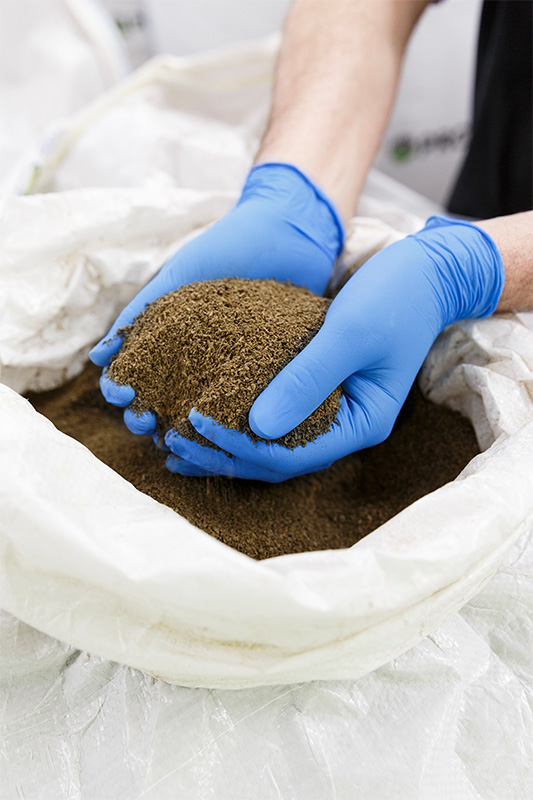
Protix offers a shelf-stable protein meal made from black soldier fly larvae that can be added to wet and dry pet food and treats.
| Source: Protix“We are currently conducting an extensive trial in partnership with ADM Pet Nutrition and the University of Illinois at Urbana-Champaign to explore these topics further and highlight any additional health benefits. We look forward to being able to share the results of this study later this year,” Madison said.
Protix offers four types of BSFL ingredients for wet and dry foods and treats. There’s shelf-stable protein meal, fresh and frozen pasteurized insect meat, and insect fat.
“A recent independent Life Cycle Assessment conducted by the renowned Deutsches Institut für Lebensmitteltechnik shows outstanding sustainability scores for all four of our insect ingredients,” van den Eshof said. “Highlights of the study include evidence that the carbon dioxide footprint and impact on global warming are up to 24 times lower when poultry meat is replaced with insect meat. Additionally, replacing coconut oil with insect fat in pet food returns over 12 square meters of arable land to nature for each kilogram of lipids.
“Our aim is to bring the food system back into balance with nature,” she said.
Ÿnsect, which is based in Évry-Courcouronnes, France, produces animal feed from mealworms. Options include high-concentrated protein products, protein hydrolysates and oils, both for dry and wet pet food applications.
“Using mealworms guarantees a premium nutritional quality with the highest protein content (71%) on the market,” said Antoine Hubert, chief executive officer and founder. “Ÿnsect has specifically targeted the pet food industry by producing appetizing, odorless and light brown ingredients with exceptional nutritional properties. They have a low ash content and are also a source of linoleic acid and natural fibers.”

Ÿnsect was founded 12 years ago with a mission to create a sustainable, healthy solution to feed the world.
| Source: ŸnsectMealworm protein not only scores high on nutritional quality. It also has a relatively low environmental footprint when compared to other pet food proteins of equivalent quality.
“A pet food using mealworms as its protein source could be considered a nutritionally sustainable pet food; and indeed, even partial replacement of a more traditional protein source with mealworms would improve the sustainability quotient of the food without compromising its nutritional quality,” Hubert said. “It may be used as the only source of protein in pet food formulation or in combination with other protein sources to meet protein and amino acid requirements.”
Research has shown varied health benefits in pets when they switch to a mealworm diet. This includes a decrease in skin disease, improved feces consistency and a lowering of cholesterol.
Not all mealworms are created equal. In a recent study published in the Journal of Animal Science (January 2023), researchers from the Department of Animal Sciences at the University of Illinois at Urbana-Champaign evaluated the amino acid composition, digestibility and protein quality of four mealworm-based ingredients. The meal ingredients came from two species — Alphitobius diaperinus and Tenebrio molitor — in formats such as whole, defatted and hydrolyzed, in order to study the differences in species and the effect of processing. Ingredients were provided by Ÿnsect.
Overall results showed mealworm-based ingredients are high-quality protein sources. Because this study was performed on roosters, additional research is necessary on dogs and cats to confirm palatability and digestibility.
In addition to being a supplier of mealworm ingredients, Ÿnsect is expanding into the pet food business with its own brand: Sprÿng.
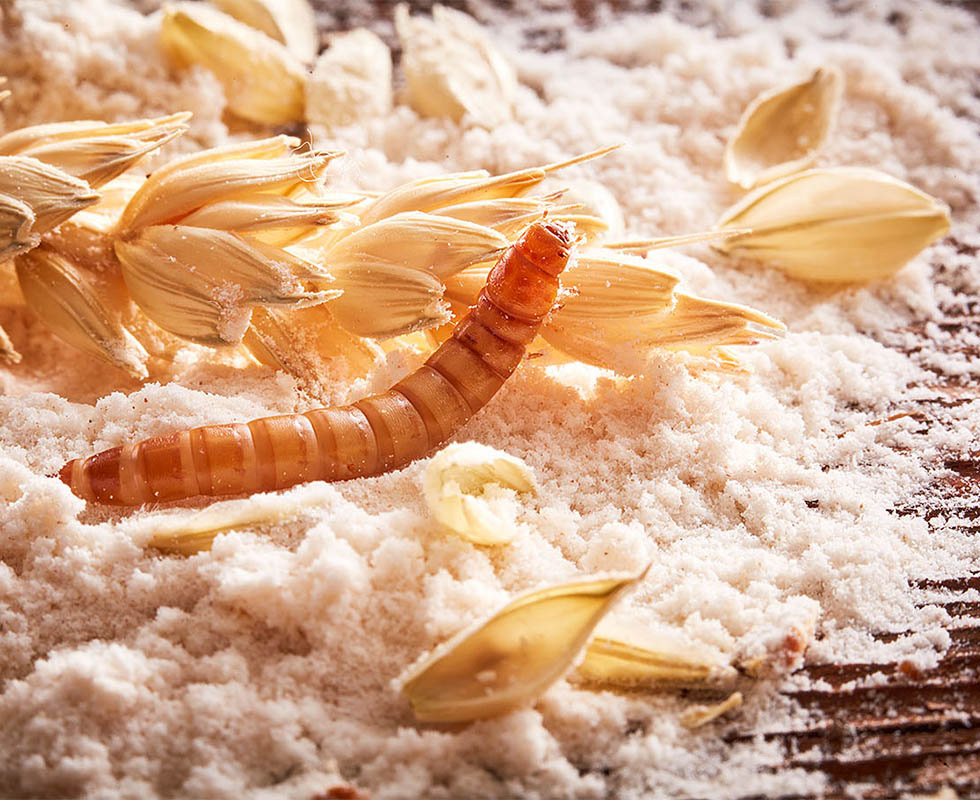
Aside from providing insect ingredients to the pet food sector, Ÿnsect is now venturing into the pet food business with its own brand: Sprÿng.
| Source: Sprÿng by Ÿnsect“Twelve years ago we created Ÿnsect to bring a natural, healthy and sustainable solution to feed the world,” Hubert said. “We’ve grown a lot and our structure and vision has evolved as well. Sprÿng expresses that wish to accelerate on such a strategic B-2-B-2-C market, where our products can bring so much to our customers and pet owners.”
The insect ingredient business is a relatively young industry, concluded van den Eshof. It’s one with unlimited potential for both the planet and for pets.
“Two recent scientific studies, for example, suggest strong antioxidant activity in insect protein. This may support healthy aging and longevity,” van den Eshof said. “Other studies provide evidence of the microbial effects of insect ingredients. These strong messages help to steer pet owners’ choice of feed.”
Read more about product development, ingredients and formulation.
